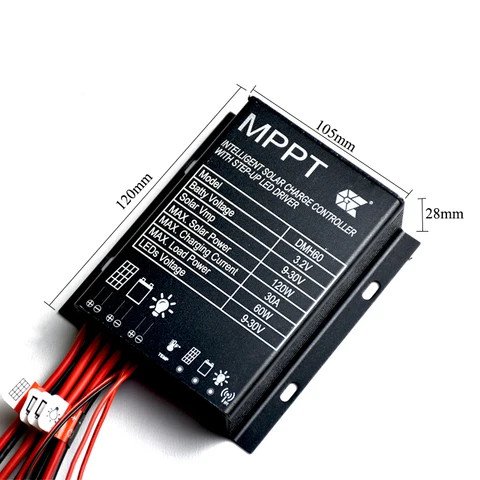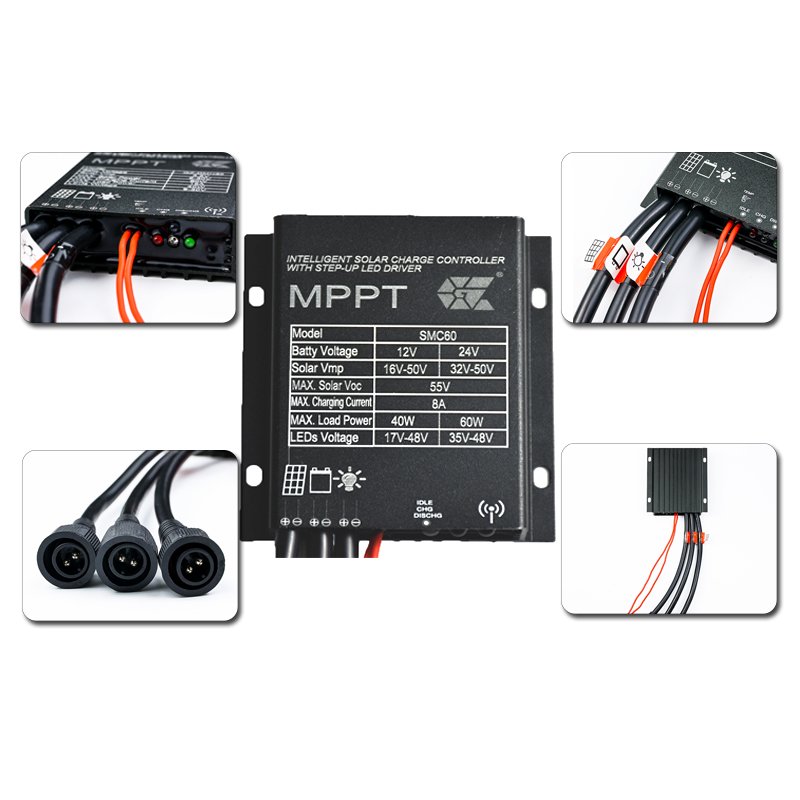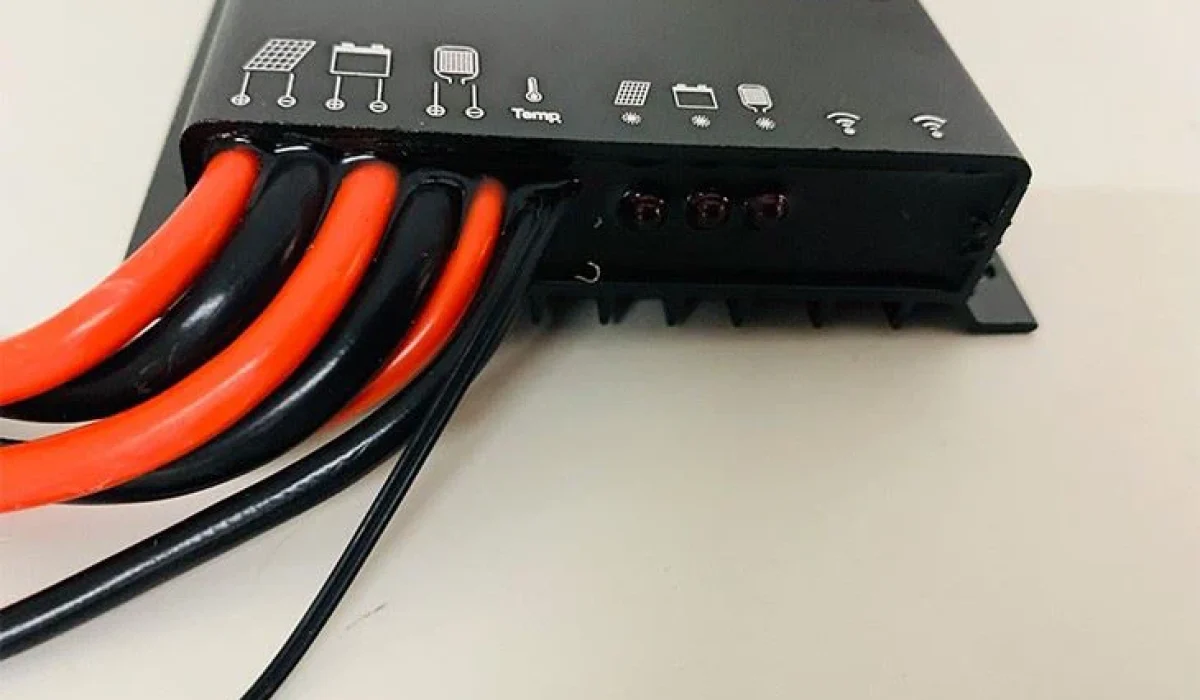A solar street light controller is the central brain of a solar lighting system. It manages how power flows between the solar panel, battery, and LED lamp, ensuring that lights automatically turn on at night and off during the day.
A solar street light controller controls lighting by using preset timing or automatic light-sensing modes to turn lights on at night and off during the day.
In short, it’s what makes a solar street light “smart.” Let’s explore how it works, the different control modes, and how to choose the right one for your project.
What Is a Solar Street Light Controller?
A solar street light controller is a compact electronic device that connects the solar panel, battery, and LED lamp in a solar lighting system.
Its main purpose is to manage charging, discharging, and lighting operations—automatically controlling when the street light turns on or off based on light conditions or preset timing.
Core Functions:
- Voltage Detection: Monitors battery voltage to control charging/discharging.
- Charging Control: Manages how the battery stores energy from the solar panel.
- Discharging Control: Regulates power output to the LED light.
- Lighting Control: Automatically turns the light on at night and off during the day.
In essence, the controller ensures system efficiency, protects components, and extends battery life.
How Does a Solar Street Light Controller Turn Lights On and Off at Night?
Controllers use one or both of the following modes to control street lighting:

🌙 Timing Control Mode
In this mode, the controller uses preset schedules to determine when lights turn on or off.
For example:
- Turn on: 6:30 PM
- Turn off: 6:00 AM
These times can be adjusted manually or automatically within the controller’s software. Seasonal variations—such as later sunsets in summer and earlier sunsets in winter—may require occasional adjustment.
Best for: Urban or highway projects where lighting schedules are predictable.
☀️ Automatic Light Control Mode
In automatic mode, the controller uses a photoresistor (light sensor) to detect ambient light.
How it works:
- During the day, sunlight keeps the photoresistor’s resistance low, signaling the controller to keep the lights off.
- As the environment darkens, resistance increases, prompting the controller to turn the lights on.
Some controllers use the solar panel’s voltage instead of a separate sensor. When panel voltage drops below a certain level (e.g., after sunset), the controller activates the lights.
| Mode | Control Method | Flexibility | Accuracy | Best Use |
|---|---|---|---|---|
| Timing Control | Preset schedule | Moderate | High (if calibrated) | Fixed routines |
| Automatic Control | Light-based detection | High | Dependent on sensor quality | Varying conditions |
Tip: For hybrid efficiency, advanced controllers allow a mix of both modes—light-based activation with timed dimming.
Types of Solar Street Light Controllers
There are two main types of controllers used in solar street lighting systems: PWM and MPPT. Each has different efficiency levels and suitable applications.

⚙️ PWM (Pulse Width Modulation) Controller
Keywords: PWM controller, three-stage charging, solar street light charging
Overview:
PWM controllers are cost-effective and widely used in small solar lighting systems.
Charging Process:
- Strong Charge: Rapidly charges the battery up to ~80%.
- Balanced Charge: Slows down charging to avoid overheating.
- Floating Charge: Maintains full charge without overcharging.
Advantages:
- Simple, durable, and inexpensive.
- Effective for smaller systems (under 2kW).
Limitations:
- Efficiency drops with high temperature or variable solar conditions.
- Less effective in maximizing solar panel output.
⚡ MPPT (Maximum Power Point Tracking) Controller
Overview:
MPPT controllers are advanced versions that maximize solar panel output by continuously tracking the panel’s optimal power point.
Charging Stages:
- MPPT Current-Limiting Stage: Dynamically adjusts input voltage for maximum energy capture.
- Constant Voltage Equalizing: Balances the battery charge safely.
- Floating Charge: Keeps the battery at stable voltage to extend lifespan.
Advantages:
- 15–30% higher efficiency than PWM.
- Performs better under varying temperatures and shading.
- Ideal for large or high-demand systems (>2kW).
Limitations:
- Higher cost.
- More complex internal design.
⚖️ PWM vs. MPPT Controller Comparison
| Feature | PWM Controller | MPPT Controller |
|---|---|---|
| Efficiency | Moderate (70–80%) | High (90–98%) |
| Cost | Low | Higher |
| System Size | <2kW | >2kW |
| Voltage Compatibility | Fixed | Wide Range |
| Temperature Impact | Sensitive | Stable |
| Control Method | Simple | Intelligent |
Quick Insight: For small rural or compound systems, PWM works fine. For municipal or highway projects, MPPT delivers long-term savings and reliability.
How the Controller Ensures Battery Health and Longevity
The controller plays a critical role in protecting battery health through three-stage charging management:
- Overcharge Prevention: Stops charging when voltage exceeds safe limits.
- Over-discharge Protection: Disconnects the load before battery damage.
- Floating Charge Maintenance: Keeps the battery at optimal voltage, extending life span.
Without these protections, batteries degrade faster—reducing system lifespan and efficiency.
Takeaway: A good controller can extend battery life by up to 30–40%.
Key Factors When Choosing a Solar Street Light Controller
When selecting a controller for your project, consider these factors:
- Waterproof Rating (IP Level):
- Outdoor systems should be IP65 or higher for dust and rain protection.
- System Voltage Compatibility:
- Ensure controller supports your design (e.g., 12V/24V/48V).
- Temperature Tolerance:
- Controllers in hot or coastal climates must handle -20°C to +60°C.
- Load and Current Capacity:
- Match current rating to LED and battery specs.
- Smart Functions:
- Optional remote monitoring, dimming, or IoT integration.
Pro tip: For large tenders or public projects, request datasheets showing MPPT algorithm efficiency and IP certification.
Summary: Why the Controller Is the Heart of a Solar Street Light System
The controller is the core intelligence of any solar street lighting system. It determines:
- When the lights turn on or off.
- How efficiently the battery charges and discharges.
- How long the system operates before maintenance.
Recap:
- PWM = simpler, cheaper, for small setups.
- MPPT = smarter, more efficient, for large projects.
In conclusion: Choosing the right solar street light controller ensures long-term reliability, energy efficiency, and cost savings. For commercial and municipal buyers, investing in a quality MPPT controller is the key to sustainable, maintenance-free lighting.


